
Scuba Fitness: A Treasured Chest
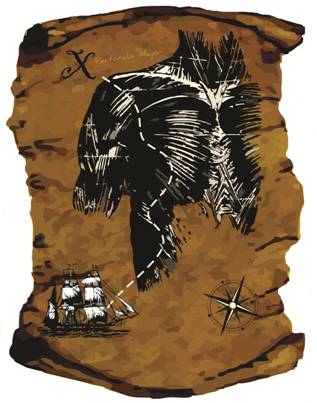
Navigating the waters of fitness for scuba diving may seem daunting however, these tried and true exercises for the major muscles of the upper body are as certain as the tides to develop a Treasured Chest.
The Chest Cavity
The chest is typically considered the front upper torso where the ribs surround and protect the invaluable heart and lungs. This area of the body is called the thoracic or chest cavity. It is separated from the abdominal cavity by the diaphragm, which is primary for breathing. The most recognized chest muscles, Pectoralis Major and Pectoralis Minor, are located in front of the ribcage, add another layer of protection to the chest cavity, and are responsible for most of the movements of the shoulders required for scuba diving activities.
The Muscles
The Pectoralis Major acts to raise and rotate the arm both to the front, side and across the body, and is also responsible for keeping the arm attached to the body. The Pectoralis Minor is responsible for moving the shoulder forward and draws the shoulder blade down and toward the center of the back.
Studies indicate that the Pectoralis Major is active during both inhalation and exhalation. The more stable the chest acting along with the diaphragm, the greater potential for increased lung capacity and ultimately oxygenation of the tissue making the difference between fatigue and endurance. Conversely, tight chest muscles may inhibit breathing capacity and can limit range of motion of the shoulders. When performed properly, strength exercises actually help to actively stretch and expand the chest. Performing stretches between exercises is also recommended to improve and maintain flexibility.
The Workout
For scuba diving, incorporate chest exercises into total body workouts at least two to four times a week. A variety of machines, barbells, dumbbells and body weight may be implemented to perform chest exercises. Pressing exercises will develop more size because the large chest muscles are able to resist more weight. However, fibers of the chest muscles act simultaneously throughout all parts of the muscle. Therefore, some strength may also be developed from a wide variety of exercises that target other muscle groups acting on the same joint such as the shoulders and triceps. For example, in addition to resistance training, swimming is a method of training the muscles of the chest.
Strength and Endurance
Foundational strength is an important step toward developing a treasured chest for scuba diving. Chest exercises may be performed for 12 or less repetitions to develop strength and size. To begin, establish foundational strength with a training cycle of six weeks. Then transition to endurance strength by performing chest exercises for a full minute in lieu of counting repetitions. Performing exercises for a full minute may initially require less weight, but importantly also trains other systems of the body to transport oxygen to the muscles more efficiently for scuba diving.
Helpful Hints:
- Record workouts in an exercise logbook to chart progress and measure results.
- Make notations of any improvements in scuba diving activities and performance.
- Place pads or folded towels under the low back and neck for added support.
Proper Form:
- Chest exercises may be performed with bent knees, which protects the low back, or on a bench with the feet on the floor.
- It is important to create a stable foundation with the body. Contract the entire body during the lift.
- Once the lift has started, do not move the feet, buttocks or head.
- Keep the elbows slightly bent at extension; do not overreach.
- Tuck shoulder blades down and toward the center of the back.
- Control the speed of the movement with a rythmic duration of two to four seconds each direction.
Range of Motion:
- Notice the elbows are at approximate right angles and aligned with the shoulder at critical positions of the chest press, chest fly and push up.
- It is not necessary or advised to lower the weight or body all the way to the chest.
- Moving beyond approximately a 90° angle of the elbow ends efficient contraction of the muscles, begins stretching the muscles under load and increases risk of injury to associated joints.
Breathing:
- Once in the starting position, for most chest exercises inhale while performing the first movement of the exercise and exhale during the second movement of the exercise.
- Regardless of the exercise the exhale is always with the exertion.
- Control breathing for the length of the range of motion in each direction.
Caution:
- When performing exercises for the chest, shoulder injuries and muscles strains most often occur with too wide a grip or by performing chest exercises too deep.
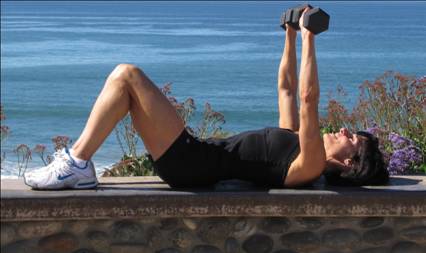
Chest Press
Chest Press with Dumbbells: Start and Finish Position
This beginning position is the safest. Minor adjustments of the body can be made before starting the exercise.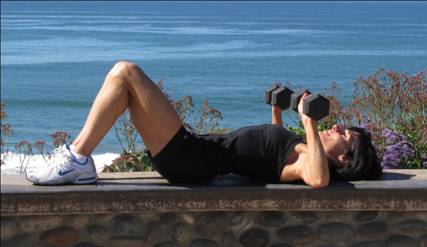
Chest Press with Dumbbells: Press Position
Imagine the press position as the base of a triangle. Move the hands along the sides of the triangle towards the peak to return to the start position.
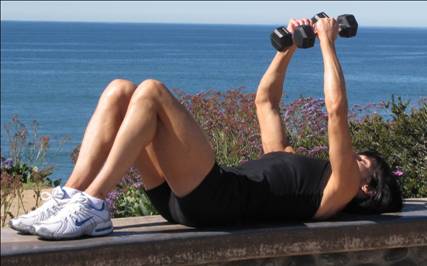
Chest Fly
Chest Fly with Dumbbells:
Start and Finish Position
Set up with oval arms as if reaching around a barrel. Open the fly as if opening double doors.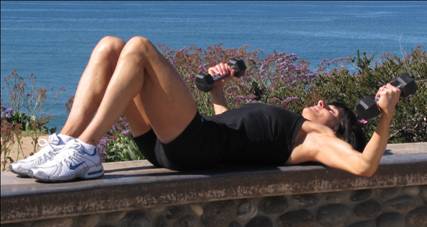
Chest Fly with Dumbbells:
Fly Position
Control the torso. Do not allow the back to arch to compensate for tightness in the chest and shoulders.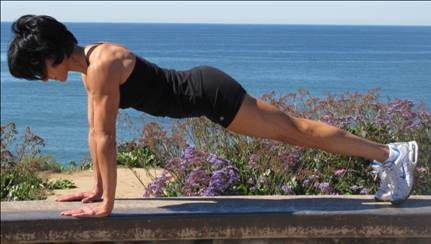
Chest Push Up
Chest Push Up:
Start and Finish Position
Contract the abdominals to support the low back. For beginners, or divers with low back and shoulder complications, the chest push up may be performed on the knees or leaning against a wall, dresser or bench at varying heights.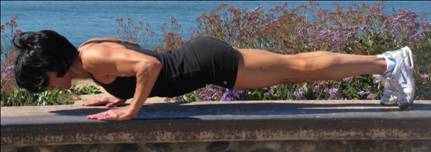
Chest Push Up:
Press Position
Notice the head is in line with the spine.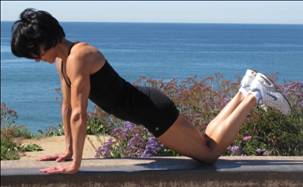
Chest Push Up on Knees: Start and Finish Position 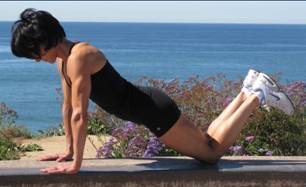
Chest Push Up on Knees: Press Position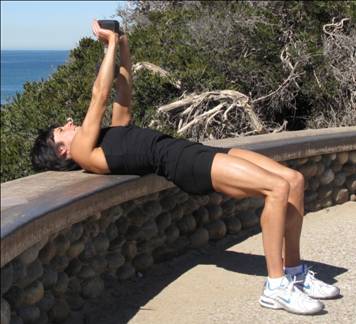
Chest Pullover
Chest Pullover with Dumbbell:
Start and Finish Position
This exercise is proven to expand the chest cavity and has been performed to rehabilitate after injury allowing for improved breathing capacity. It may be performed with the body lengthwise on a bench with the feet on the floor or bench, and on the floor with knees bent to support the low back.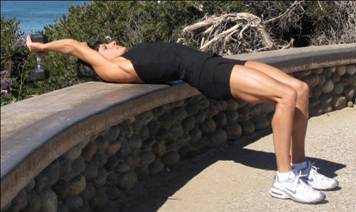
Chest Pullover with Dumbbell:
Reach Position
Reach only to the range of motion and strength that feels comfortable. Do not arch the back to accommodate greater range of motion. Pull in on the abdominals when returning to the start position for added abdominal strengthening.
Fitness Model: Loren Kurz is a long-time friend, fitness professional and business associate. She has been weight training for 25 years, runs marathons and a variety of other road races, played competitive women’s soccer for many years, and has been a challenger on American Gladiator.
Written by Gretchen Ashton, San Diego, California.